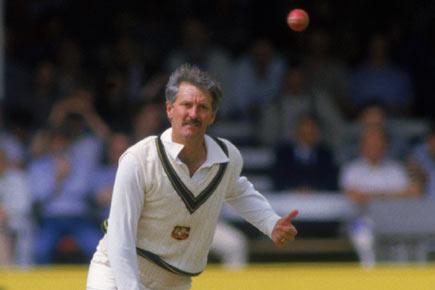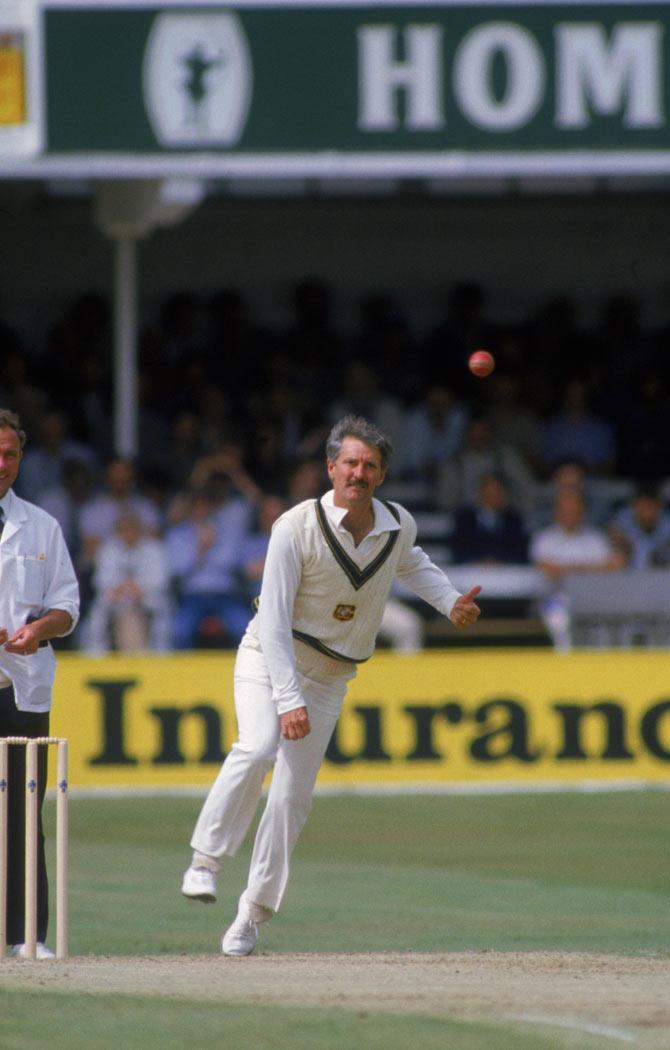Late Australian leg-spinner Bob Holland will be remembered for his three Test match-winning performances in the space of one year


The late Australia leg-spinner Bob Holland in full flight during the Trent Bridge Test against England in 1985. PIC/Getty Images

Through the death of Bob Holland, the international cricket fraternity has lost a late bloomer, an unassuming individual and a leg-spinner who, in a short career of 11 Tests, played a leading hand in three Test victories for Australia – all in 1985.
Brain cancer got the better of ‘Dutchy’ Holland last Sunday, aged 70. He was with his cricketing mates at a tribute night in his beloved Newcastle, New South Wales (NSW) two nights before he passed away peacefully.
Greg Chappell’s youngest brother Trevor, a NSW teammate, who attended the charity dinner for Holland on Friday, told me: “He was there and not looking particularly well. However, it was quite a shock to hear he had passed away over the weekend. Dutchy was a great guy to have in the team, he never got upset, loved the game and was always interested in how his teammates were doing.”
In a way, Holland was a unique cricketer. He was considered good enough to play first-class cricket for New South Wales when he was 32. Six years later, in 1984, the greying Holland became Australia’s third oldest Test debutant and faced the mighty West Indies at Brisbane, where the hosts lost and Kim Hughes quit the captaincy in tears. That very summer, Hughes was quoted as saying, “Leg spinners in Australia against good players don’t bowl tight enough, don’t have enough variety and simply aren’t good enough.”
If at all Holland found Hughes’ pre-series comment deflating, he may have screwed his face while reading the comments of Jeff Thomson, who was to be Holland’s teammate on the 1985 Ashes tour to England. “If they try spin they’ll have to buy more balls because the Windies will keep hitting them out of the ground,” said Thomson. Ex-Test off-spinner Ashley Mallett didn’t sound optimistic too when he said, “Holland is a useful spinner at Sheffield Shield level, but I am afraid, the Windies would dine lavishly on his tempting deliveries. But selectors Laurie Sawle, Greg Chappell, Rick McCosker and captain gave Holland the opportunity and he struck in the fifth and final Test at Sydney even though the Sir Frank Worrell Trophy was well and truly surrendered by the now Allan Border-led Australia.
The selectors and captain had done well to take into consideration NSW’s Holland and left-arm spinner Murray Bennett’s match-winning performance over the West Indies in a tour game in November 1984. Bennett, who was handed his baggy green cap in the Melbourne Test, got picked for Sydney too and they bowled Australia to an innings victory in Sydney to put off the party lights for Clive Lloyd’s Test farewell. Viv Richards was the prize wicket to get. When Holland bowled to him, Richards lofted him high over mid-off but Greg Ritchie spilled the chance and Holland feared the master batsman would not give them another chance. But at 106 for four, Richards perished through a slip catch by centurion Kepler Wessels off Holland for 15. Holland ended up with six for 54, as West Indies were bowled out for 163. They fared a bit better while following on, but couldn’t avoid their first defeat to Australia in four seasons and their first innings defeat in 17 years. Holland claimed a bag of four wickets in the second innings and with it a souvenir stump, possibly the off stick which was disturbed when he bowled opener Gordon Greenidge early on that fourth day.
“Holland’s match figures spelt out the reason for the West Indies reverse in irrefutable terms: 55 overs, 15 maidens, 174 runs, 10 wickets,” wrote Frank Tyson in Channel Nine’s 1985 Yearbook.
The square turner at Sydney displeased skipper Lloyd, but he went into the Test with a four-pronged pace attack, dropping Roger Harper for Michael Holding. “If Borg and McEnroe were coming to play tennis at Kooyong, do you give them a bad tennis court? No, you give them the best,” Lloyd told reporters during his final press conference on the visitors’ balcony of the Sydney Cricket Ground (SCG).
In an interview to the Newcastle Herald a couple of years ago, Holland revealed that he and his spin twin Bennett travelled in a chauffeur-driven car to be interviewed in a television studio at 5:30 the following morning, which was not the easiest thing to do after a late-night celebration.
Later that year, in the English summer of 1985, Holland’s five for 68 from 32 overs spun Australia to victory in the second Test at Lord’s. However, he could take only one wicket in the remaining three Tests he figured in. Iconic commentator Alan McGilvray put that down to Border’s poor handling of his chief leg-spinner, although he didn’t want to sound too harsh on a then-inexperienced captain.
When a gritty New Zealand side had to be tackled at the SCG in November 1985, after their innings victory in the previous Test at Brisbane, Holland came up with another match-winning 10-wicket haul on his home ground. Bowling master craftsman Martin Crowe round his legs for a duck in the second innings ended up being a memorable scalp.
Holland, however, took a beating when he bowled to the Indians in the Sydney Test of early 1986. He could have sent back Sunil Gavaskar much before he dismissed him (off a full toss) for 172 had Geoff Marsh held on to Gavaskar’s pull shot the previous day. There can never be a long future for a 39-year-old and that was Holland’s final Test. He continued to serve NSW cricket by coaching young players in Newcastle and will be remembered for his good work in that sphere, just like his presence in two NSW Sheffield Shield-winning squads and his short Test career.
He was a rabbit with the bat at Test level and at one stage had five ducks in a row. But his stubborn batting helped NSW in their 1984-85 and 1985-86 Sheffield Shield triumphs. Trevor Chappell recalled a memorable catch as well when he first played alongside Holland in the NSW team at the SCG in 1979-80 after moving over from South Australia. The eldest Chappell was in his final season of first-class cricket. “Ian made a century in the first innings and they were not chasing a big score (168) in their second innings. In the first innings, Ian had engaged NSW quick Len Pascoe in quite a few words. The end result was that Len bowled many bouncers to Ian, which he quite enjoyed. Our captain McCosker had instructed Len not to bowl any bouncers to Ian in the second innings. However, he set a deep fine leg and deep backward square leg; the deep backward square leg being Dutchy, who was not noted for his fielding or batting as he spent all his time at training bowling. Len pitched the first delivery to Ian well up, but could not restrain himself any more. The second ball was a bouncer which Ian hit straight to Dutchy who fortunately for NSW, caught the ball. NSW won by 98 runs."
John Benaud, a NSW player himself, summed up Holland’s international career and personality well when he retired from Australian first-class cricket in 1987 (he played the 1987-88 season for Wellington in New Zealand). Benaud’s words that appeared in the October 1987 issue of Australian Cricket magazine were: “Bob wasn’t really star status, but in an era that was saturated with bumpers, bouncers and bodyline, he spun a swirl of fresh air with his dainty leg-spin.” John should know; his father Lou and famous brother Richie were leg-spinners. In his match summary on Channel Nine, Richie Benaud hoped that spin would regain importance in Test cricket. It did and who’s to say Holland did not have a role to play in it.
mid-day's group sports editor Clayton Murzello is a purist with an open stance. He tweets @ClaytonMurzello. Send your feedback to mailbag@mid-day.com
 Subscribe today by clicking the link and stay updated with the latest news!" Click here!
Subscribe today by clicking the link and stay updated with the latest news!" Click here!









